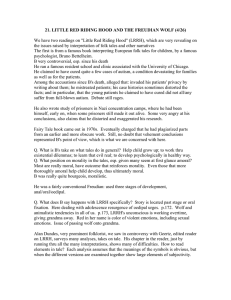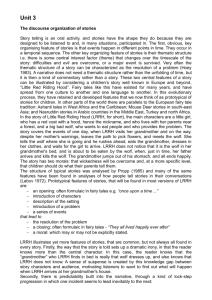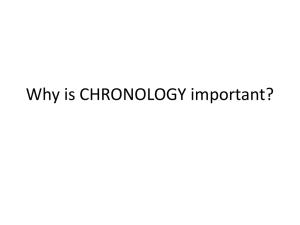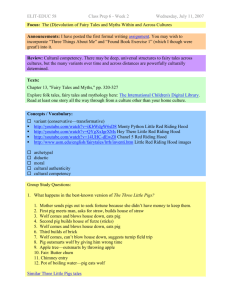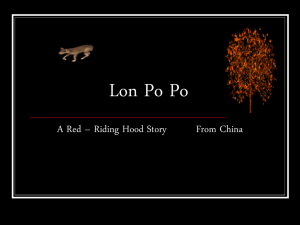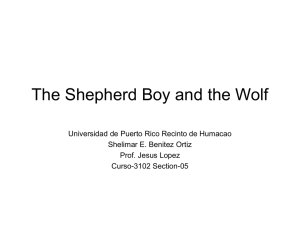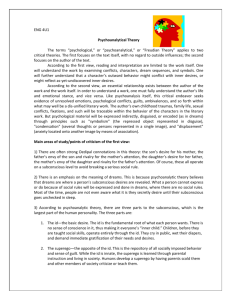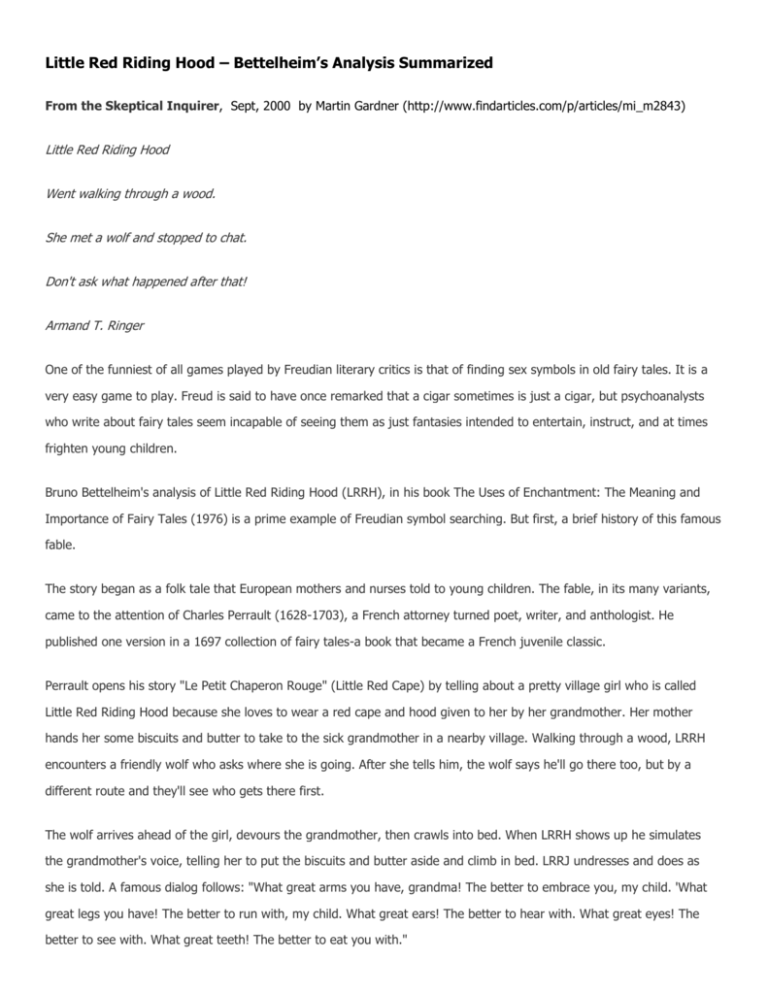
Little Red Riding Hood – Bettelheim’s Analysis Summarized
From the Skeptical Inquirer, Sept, 2000 by Martin Gardner (http://www.findarticles.com/p/articles/mi_m2843)
Little Red Riding Hood
Went walking through a wood.
She met a wolf and stopped to chat.
Don't ask what happened after that!
Armand T. Ringer
One of the funniest of all games played by Freudian literary critics is that of finding sex symbols in old fairy tales. It is a
very easy game to play. Freud is said to have once remarked that a cigar sometimes is just a cigar, but psychoanalysts
who write about fairy tales seem incapable of seeing them as just fantasies intended to entertain, instruct, and at times
frighten young children.
Bruno Bettelheim's analysis of Little Red Riding Hood (LRRH), in his book The Uses of Enchantment: The Meaning and
Importance of Fairy Tales (1976) is a prime example of Freudian symbol searching. But first, a brief history of this famous
fable.
The story began as a folk tale that European mothers and nurses told to young children. The fable, in its many variants,
came to the attention of Charles Perrault (1628-1703), a French attorney turned poet, writer, and anthologist. He
published one version in a 1697 collection of fairy tales-a book that became a French juvenile classic.
Perrault opens his story "Le Petit Chaperon Rouge" (Little Red Cape) by telling about a pretty village girl who is called
Little Red Riding Hood because she loves to wear a red cape and hood given to her by her grandmother. Her mother
hands her some biscuits and butter to take to the sick grandmother in a nearby village. Walking through a wood, LRRH
encounters a friendly wolf who asks where she is going. After she tells him, the wolf says he'll go there too, but by a
different route and they'll see who gets there first.
The wolf arrives ahead of the girl, devours the grandmother, then crawls into bed. When LRRH shows up he simulates
the grandmother's voice, telling her to put the biscuits and butter aside and climb in bed. LRRJ undresses and does as
she is told. A famous dialog follows: "What great arms you have, grandma! The better to embrace you, my child. 'What
great legs you have! The better to run with, my child. What great ears! The better to hear with. What great eyes! The
better to see with. What great teeth! The better to eat you with."
The wolf then gobbles up LRRH and the story ends! I have been told, though I strongly doubt it, that French children find
this ending amusing, and are not in the least disturbed by it. Andrew Lang, who reprinted Perrault's version in his Blue
Fairy Book, severely criticizes Perrault for choosing a version with such a gruesome ending.
When the German brothers Jacob and Wilhelm Grimm later published in 1812 their collection of more than 200 traditional
fairy tales, many taken from Perrault, they gave the story a less grim ending. In their version (you'll find it in the Modern
Library's Tales of Grimm and Andersen), LRRH's mother gives her cake and a bottle of wine to take to the ailing
grandmother. LRRH is not afraid of the wolf when she meets him in the forest. He persuades her to pick some flowers to
rake to her grandmother. While she is doing this (disobeying her mother who told her not to dawdle) the wolf hastens to
the grandmother's house, finds the door unlocked, enters, and promptly eats the grandmother.
When LRRH arrives she is surprised to find the door open. She thinks it is her grandmother in bed because the wolf has
pulled a nightcap over his face, and sheets over his body. LRRH stands beside the bed while the familiar dialog occurs
about the wolf's body parts. The wolf then springs out of bed and eats LRRH. He now goes back to bed and falls asleep.
A passing hunter hears the wolf's loud snores. He goes inside to investigate and is about to shoot the wolf until he
realizes it may have eaten the grandmother. So he pulls out a knife and cuts open the wolf's belly. Both LRRH and the
grandmother emerge as unharmed as Jonah when he was vomited out of the whale's belly.
LRRH brings some big stones into the house to put inside the wolf, who is still asleep. When he awakes and tries to get
away, the heavy stones drag him down and he drops dead. The hunter skins the wolf and takes the skin home. The
grandmother can hardly breathe, but she feels much better after eating the cake and drinking some wine. LRRH says to
herself, "I will never again wander off into the forest as long as I live, when my mother forbids it."
The tale is short and simple. Its obvious moral is that children should obey their mothers when they walk through
dangerous areas, and to beware of seemingly friendly strangers. I suppose it is the linking of LRRH's beauty and
innocence with her grisly experience that has led to her capturing the hearts of so many adults everywhere, especially in
Germany, France, Sweden, and England. "Little Red Riding Hood was my first love," declared Charles Dickens. "I felt that
if I could have married Little Red Riding Hood, I should have known perfect bliss."
Bruno Bettelheim devotes eighteen pages of his book on fairy tales to LRRH. [1] In his eyes the girl is not as innocent as
she seems. She is at the nymphet stage when her premature "budding sexuality" is creating deep unconscious conflicts
between her id (animal nature) and her superego (conscience), as well as between her allegiance to what Freud called
the "pleasure principle" and the "reality principle." Unconsciously, she wants to be seduced by her father. The wolf's
eating her represents that seduction.
The red color of LRRH's hood, according to Bettelheim, symbolizes her unconscious sexual desires. He sees the gift of the
hood by the grandmother as representing a transfer of sexual attractiveness from an old sick woman to a young healthy
girl. The grandmother is a symbol of the little girl's mother. When the wolf ears the grandmother it represents the little
girl's wish to get rid of her mother so she can have her father all to herself.
In Grimm's version, Bettelheim sees the hunter as another father symbol. When he cuts open the wolf's belly it indicates
"the idea of pregnancy and birth," thus coming "too close for comfort in suggesting a father in a sexual activity connected
with his daughter."
Bettelheim, of course, is not the only Freudian to read dark sexual meanings into the story. Psychoanalyst Erich Fromm,
in The Forgotten Language: An Introduction to the Understanding of Dreams, Fairy Tales, and Myths (1951) is also
convinced that LRRH is experiencing unconscious sexual impulses and really wants to be seduced by the wolf. The red
cape symbolizes her menstrual blood as she enters womanhood. When the mother warns her not to leave the path or she
might fall and break the wine bottle, it represents the mother's fear that her daughter might lose her virginity by breaking
her maidenhead.
"The male is portrayed as a ruthless and cunning animal," Fromm writes. The sexual act becomes a "cannibalistic act in
which the male devours the female." Fromm sees this as an expression of a deep antagonism toward men by frigid
females who do not enjoy sex. The male wolf is "made ridiculous" by showing "that he attempted to play the role of a
pregnant woman, having living beings in his belly." The stones that LRRH puts in the wolf's stomach are "symbols of
sterility" that cause him to collapse and die. The stones "mock his usurpation of the pregnant woman's role."
"The story," Fromm concludes, "speaks of the male-female conflict; it is a story of triumph by man-hating women, ending
with their victory, exactly the opposite of the Oedipus myth, which lets the male emerge victorious from this battle."
Jack Zipes, who teaches German at the University of Minnesota, is the author of The Brothers Grimm (1986), a twovolume edition of Grimm's stories, a collection of French folk tales, and other books on folklore. One of his books is titled
The Trials and Tribulations of Little Red Riding Hood (1983, updated in 1993). The book is a marvelous scholarly history
of the LRRH fable and its many versions and interpretations.
Zipes covers all the oral variations that preceded Perrault, as well as the many retellings by writers from the Grimm
brothers to 1993. Some of the oral tales are even more morbid than Perrault's version. In several versions the Wolf slices
up the grandmother and pours her blood into a bottle. LRRH then eats and drinks what she thinks is meat and wine
before the wolf eats her. In other versions LRRH escapes by telling the wolf she has to go outside to relieve herself.
Thirty-eight variations of the tale are reprinted in Zipes's anthology, along with a raft of illustrations from books and
advertisements. At the back of the book he lists 147 published versions of the story, including retellings by Walter de la
Mare and James Thurber, as well as comic parodies, poems, plays, recordings, musicals, and films. His bibliography of
critical references runs to 153 items!

